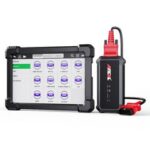The Golf 4, like many vehicles from its era, uses the OBD2 protocol for diagnostics. Connecting to the car’s ECU requires understanding this protocol and sending the correct commands. This involves initializing communication and then requesting specific data points using defined codes.
A successful connection starts with turning the ignition ON, not just to the accessory position. The engine can be running or not. The Golf 4’s ECU often requires an initialization sequence. A common initialization string involves sending bytes like 0x0F, 0xFF, 0xFE. Keep in mind that these bytes might be inverted and at RS232 levels, requiring proper conversion for successful communication.
Reading data requires sending specific commands structured with a header, data request, and expected length. For instance, to read the battery voltage, a command might resemble 0x0F (accept command), 0x0A (Battery Voltage), 0x02 (send 2 bytes). Similarly, requesting multiple data points like battery voltage, speed, and RPM would involve a command like 0x0F (accept command),0x0A (Battery Voltage), 0x07 (Speed), 0x08 (RPM), 0x06 (send 6 bytes). Remember that these are example values and the actual codes may vary. Consult your Golf 4’s specific documentation for accurate command codes.
Dedicated OBD2 interfaces, such as those available from SparkFun, often handle much of this low-level communication automatically. They translate higher-level requests into the specific byte sequences needed by the ECU, simplifying the process.
Before attempting complex data retrieval, testing the connection with a terminal program is crucial. Establish communication with the car and confirm responses before integrating the commands into platforms like Arduino. This ensures a functional connection and allows for debugging early in the process.
While dedicated OBD-II interfaces simplify the process, the cost can be prohibitive. Developing a custom solution using a microcontroller, like a PIC18F877, and a custom interface is possible but requires deeper technical knowledge. Understanding RS232 communication and byte manipulation is crucial for DIY solutions. Ultimately, choosing between a pre-built solution or a custom build depends on technical expertise and budget.

